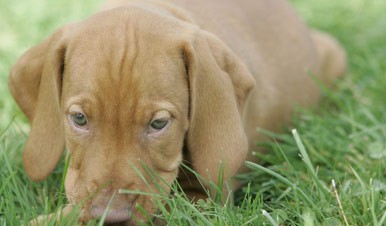AJ Debiasse, a technician in Stroudsburg, PA, contributed to this article.
Cryptorchidism occurs when one or both of the testicles are not in the scrotum (or sac). This is also called undescended testicle(s) or retained testicle(s). Although this genetic condition may not seem like a big deal, it is cause for great concern.
When a puppy is born, the testicles reside in the abdomen, near the kidneys. As your pup ages, they slowly migrate to their rightful location in the scrotum. In dogs with this genetic disorder, one (unilateral) or both (bilateral) testicles get hung up somewhere along their journey. 
Both testicles should be descended by 2 months of age and should be confirmed by your veterinarian during the first “puppy exam.” Many people believe that the “cut off” age is 6 months but this is a stubborn myth. It is very unlikely that testicles will “descend” after 2 months of age.
Where do the testicles go?
There are 2 main locations for the undescended testicle(s) to end up:
- In the belly (abdominal cryptorchid)
- Where the abdomen meets the back legs (called the inguinal region [inguinal cryptorchid])
Depending upon the location, your vet may be able to feel the undescended testicle during a physical exam.
What problems are caused by cryptorchidism?
Leaving a cryptorchid dog intact, i.e. not neutered, can cause severe health problems. One is called testicular torsion, a fairly rare situation. A testicle that is retained in the belly is free floating, instead of being secured in its intended location, so it could suddenly twist on itself. This is a very painful condition, sometimes challenging to diagnose.
It gets worse: cryptorchid dogs have a higher risk of testicular cancer. It is believed that the risk of cancer is related to a higher temperature in the belly compared to the scrotum. Even though the probability of metastasis (or spreading) is low, it is still possible. So leaving your dog intact can be an unnecessary risk.
Preventing cryptorchidism
Since cryptorchidism is a genetic disease, it is not recommended to breed dogs with this condition, as the father could pass it along to his offspring. This is actually assuming the father can reproduce. Most dogs with bilateral cryptorchidism (meaning that both testicles are retained) are sterile. The temperature inside the body is too high and sperm cells are unable to form properly.
Treating cryptorchidism
Occasionally, vets are asked to “tack” the undescended testicle inside the scrotum. This is a completely shady and unethical procedure, so it should not even be an option.
There are prosthetic “testicles” available for cosmetic purposes. Most practices do not offer this service because some people immorally use these dogs to continue to show or stud out.
Regardless of the age of your dog, and whether or not it is unilateral or bilateral, it is always recommended that you have the problem corrected. The only treatment is to have your dog neutered (i.e. both testicles removed). A cryptorchid neuter is a more involved surgery since it may involve an incision in the abdomen and a longer surgery time. Your veterinarian may recommend an overnight stay depending upon the specific procedure. Your dog’s recovery takes approximately 10 -14 days and requires restricted activity. The quieter you keep your pup, the quicker he will heal. It is also recommended to keep an Elizabethan collar on to prevent chewing and licking of the incision site (or sites) during the healing process.
If you adopt an older dog, ask your veterinarian about blood tests to differentiate between a neutered and a cryptorchid dog.
Questions to ask your veterinarian if your dog is cryptorchid:
- It is unilateral or bilateral?
- Is it abdominal or inguinal?
- What is the course of action to neuter my dog?
If you have any questions or concerns, you should always visit or call your veterinarian -- they are your best resource to ensure the health and well-being of your pets.
